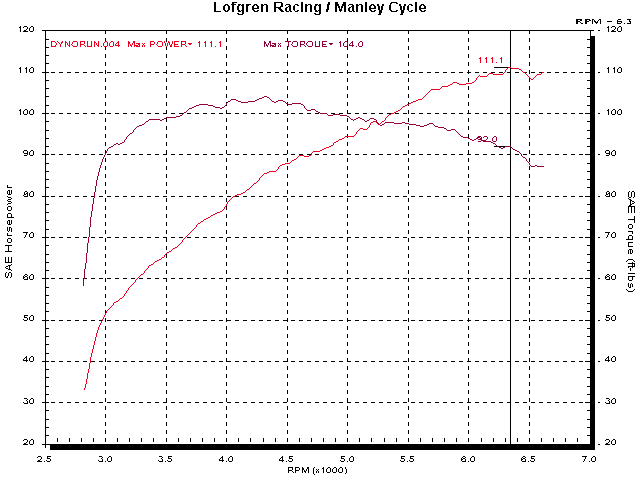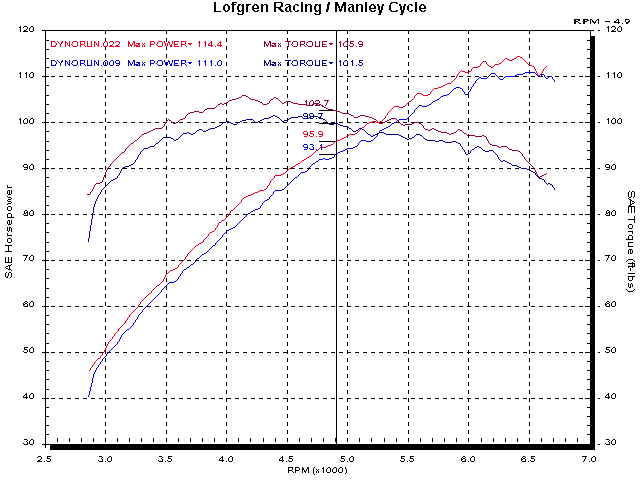
An Example of Roland's Work
I don't know how Rick Burnham heard about Mike, but he approached him about doing some engine work on his Twin Cam. He had purchased it from the dealer with the Stage 3 kit installed, so he was used to the power and made some assumptions about how much power it made.
Mike wanted to do before-and-after tests, for obvious reasons. (he too believes 'if you don't check your work, you can assume it's perfect')
Mike rode the bike over one after-noon and Rick met him at the shop.
The baseline test was a little surprising to me, but when I stop and think about it, I haven't had a stock or even a Screamin' Eagle kitted bike on the dyno before. Most of the bikes I tune are more modified than that.
Below are the results. This is the 1550 big-bore hi-compression kit with SE cams and 42mm Mikuni. I don't remember if the rev limiter was higher than 6000 but it's all done long before that point anyway.

I'm sure there's a little more in that, with some tweaking. But, Mike was going to tear it apart so away it went.
This was going to be a top-end-and-timing-chest-only kind of hop-up, so no lightened flywheels for this one.
Mike learned more about the ports with this one and installed his made-for-Roland Andrews TW11 cams which are designed with extremely good exhaust ports in mind. This allows milder exhaust lift and duration which maintains max torque without loosing HP within the operating range of the Twin Cam.
A 45 Mikuni was deemed appropriate as well as an S&S manifold. The cam timing is conservative, and the ports are big (so are the flow numbers) so a large volume manifold was needed. A Thunder-header was chosen because they tune at the right RPM for this application. (they are, however, obnoxiously loud)
A combination of S&S gear-drive cam drive and Zippers/V-Thunder ignition was used. Mike has become a believer in digital ignitions, so, the V-Thunder system is the obvious choice. Here I have to add that this system isn't an advantage if you aren't going to do the testing properly.
Mike rode the bike over to the shop after giving a bit of break-in on the street. He reported that it ran pretty well. Even lofting the front wheel in a gear higher than 1st.
When the bike was being set up on the dyno Rick showed up. I was pretty surprised by the second run.

When starting the 'process' of tuning a new combination, if the jetting is in the ball-park, the early runs can make really good power numbers because the engine isn't heat-soaked. After a few runs, the earlier power figures can become elusive. I try not to worry about it, and continue to get the air/fuel ratio correct, then the ignition timing. The chart below illustrates a run with the finalized main-jet (blue) compared with a later run after the ignition mapping is complete.

Once we had the jetting and timing right, we were occupied with a couple things and kept the dyno fans on the shut-off engine for a fair amount of time. Cooling the top-end usually helps make good power, but I was surprised by the first run number 021. It is shown with the next run, 022, the best run from the previous chart.
